Finding aphids on your indoor plants is annoying, and getting rid of them takes both time and patience. But it is possible, and you don’t have to toss out your plants.
Trust me, I know from experience. I’ve battled many outbreaks in the past, but I have successfully debugged my houseplants – and you can too.
In this post, I’ll share all of my tips and tricks for how to get rid of aphids and keep them away, FOR GOOD!
You’ll also learn about how to identify them, their life cycle, how they reproduce, the damage they cause, where they come from, and more.
They’re a common garden pest outside. But sometimes they get into your house and infest your indoor plants too, and they can become a major problem.
This is because they don’t have any natural predators inside. With nothing to stop them, they multiply very fast and can infest all of your plants in no time.
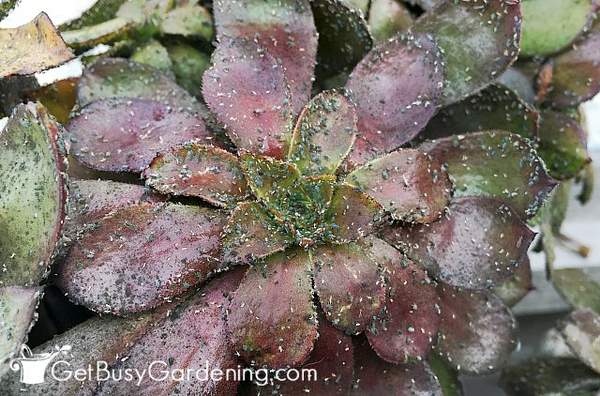
What Do They Look Like?
Many times aphids look like tiny green bugs, but they can be almost any color: red, brown, blue, yellow… you name it.
They’re easy to identify, though, because they like to cluster on new tender growth, stems, and flower buds.
They tend to blend in very well with the color of the plant. So you probably won’t even notice them until the population explodes.
They can also have wings, but winged aphids are less common. But, whatever color or form they take, they’re small, fat, and juicy – and GROSS!
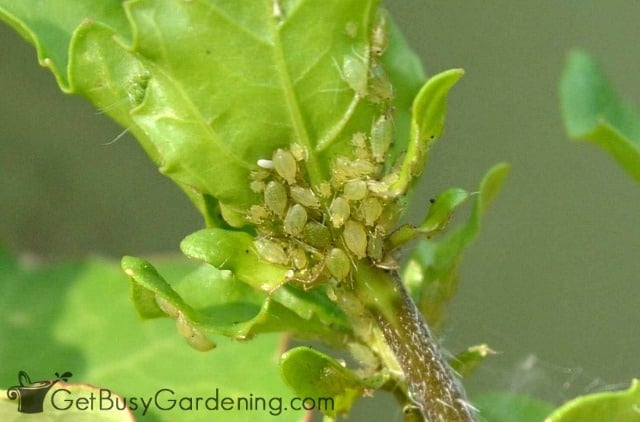
Damage To Plants
Aphids feed on houseplants by sucking the sap from them, and they like the fresh new growth and flower buds the best. Their damage causes stunted growth, deformed leaves and flowers, as well as leaf and bud drop.
As they feed, they release a honeydew-like residue. So you may notice that the area around your plant is sticky before you even see any bugs.
Thankfully, the damage isn’t usually catastrophic. Though they could eventually kill a plant, mature, healthy ones can survive a fairly large infestation.
Related Post: How To Get Rid Of Whiteflies On Indoor Plants
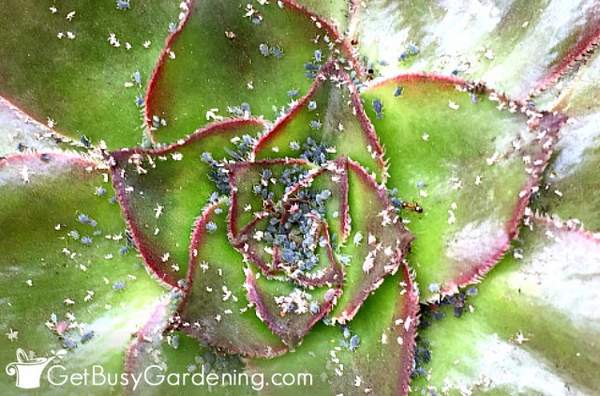
Aphids Life Cycle
The aphid life cycle is a bit different depending on the species. Some females give birth to live nymphs, while others lay eggs.
Either way, they multiply quickly – and once they get going, their population can grow exponentially.
Their full life cycle can be as short as one week. So that means that from the time a nymph is born or hatches, it can mature into an adult and start laying more eggs in as little as one week. Yikes!
The eggs are super small, so you’ll probably never see those. But you may notice what looks like a bunch of tiny white flecks on the leaves and around the base of your houseplant several days before seeing the adults.
Those are exoskeletons that the nymphs shed when they molt, which happens about four times before they’re officially adults. These whitish casts might even be the first thing you see a few days before you discover an infestation.
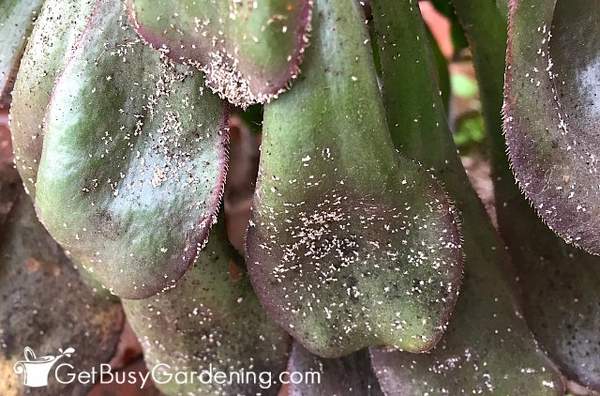
My Story
I learned the hard way how fast they can spread indoors. I will forever remember the winter of 2009 as the year of the worst aphids outbreak I’ve ever had.
I found them on one of my houseplants, and they quickly spread to over half of my collection. I spent the entire winter battling them. I was on the brink of throwing all of my houseplants out into the snow and giving up (how you like me now, aphids?).
But I was determined to save my plants, and ultimately I figured out how to win the battle. My indoor plants remain aphid-free to this day, so I know what works to eliminate them.
Where Do Aphids Come From?
The moment you discover aphids on an indoor plant, you’ll probably wonder, where the heck did they come from in the first place?
Houseplant pests can come from anywhere, and you may never figure out exactly how they got into your house. But here are the most common sources:
- Houseplants that spent the summer outside
- Fresh flowers, herbs, or produce from your garden
- A new houseplant you bought at the store
- Through window screens or doors
Aphids & Ants
As with mealybugs, if you have ants, they may actually be the cause of the problem. Ants will bring these sap-sucking bugs to a plant so that they can feed off of the sweet honeydew the pests excrete when they feed.
So, if you have ants in your house, then that may be where the aphids are coming from.
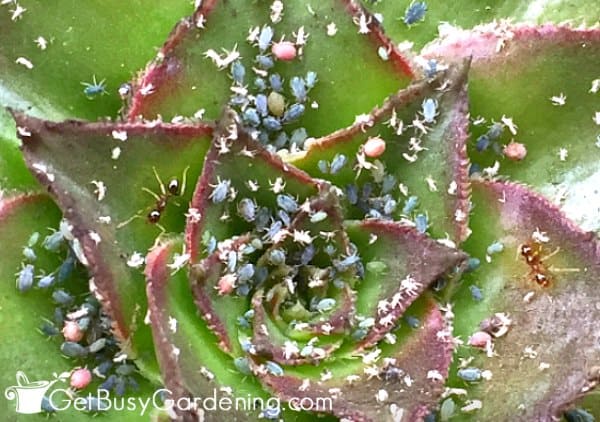
How To Get Rid Of Aphids On Houseplants
Once you discover aphids, it’s important to begin treatment immediately. Otherwise they can spread like wildfire to your other houseplants.
When the original host plant becomes overcrowded, the adults will start migrating, and they can easily crawl or fly to infest any others that are nearby.
Here are the first steps you should take right away to control an outbreak:
- Quarantine the affected plant immediately
- Thoroughly clean the area where it was sitting
- Wash your hands before touching any other plants
- Inspect all the surrounding ones for signs of aphids
- Begin treating the infested plant(s) ASAP
5 Natural Aphid Treatment Methods
The best way to treat aphids on indoor plants is to use all natural pest control methods, rather than synthetic pesticides. These bugs can become immune to chemicals, which will make your problem worse in the long run.
Also, before using any type of soaps or sprays, test them on a few leaves first to make sure there’s no damage before treating the whole thing.
Below are the organic methods I use and recommend. Whatever you do, you must be persistent. You can’t treat a plant once and expect the aphids to go away forever.
1. Wash The Leaves
The first thing I do when I find aphids on my indoor plants is wash the leaves. You can do this task in the sink or the shower, just make sure you don’t flood the pot in the process.
To start, spray the leaves with a strong stream of water to rinse off all of the adults and nymphs that you see. Make sure to focus on new leaves and flower buds, because that’s where they like to congregate.
Then wash your houseplant with a weak solution of mild liquid soap and water, which will kill the adults, nymphs, and eggs on contact. Be sure to rinse off all the suds afterward.
2. Insecticidal Soap
Another great home remedy for getting rid of aphids on plants is to use a soapy spray to kill them. You can buy an organic insecticidal soap, or whip up a batch of your own using my recipe:
- 1 teaspoon of mild liquid soap
- 1 liter tepid water
These sprays will kill aphids on contact, but they have no residual effect. So be sure to treat them on a regular basis until all signs of the bugs are gone.
3. Neem Oil
Another great option that is very effective for getting rid of aphids long term is neem oil. This is an organic insecticide, and it also has a residual effect to prevent future infestations.
It really works wonders, and I highly recommend it. But, while it can kill many of the bugs on contact, it does take some time to get rid of them completely.
So make sure to stay consistent. Treat your plants every few weeks until you no longer see any of the bugs or nymphs.
Related Post: How To Use Neem Oil On Indoor Plants
4. Rubbing Alcohol
You could also try using rubbing alcohol to treat aphids on your indoor plants. Simply soak a cotton swab with it, then dab it directly on the bugs. Or spray a 50/50 mix of rubbing alcohol and water on the leaves.
This will kill the bugs immediately, but it has to come in direct contact with them. It’s great for treating a small outbreak, but there’s no residual effect. So check your plant daily and swab off any new bugs that you see.
Related Post: How To Get Rid Of Scale Insects On Houseplants
5. Sticky Traps
Some adult aphids have wings, and they can fly around to lay eggs your other houseplants. This also means they could fly away as soon as you start treating the leaves, so sprays won’t be as effective on them.
If you take a closer look, you can easily see the ones that have wings. Whether you spot any winged adults or not, I recommend getting some yellow sticky traps to hang next to the infested plant to capture them.
It’s very rare to see them flying around though, so if the bugs you find are black, then those are probably fungus gnats, and here’s how to get rid of them.
How To Prevent Aphids From EVER Coming Back
Aphids are tough opponents, and it can take some time to eliminate them completely. Especially if you have a large collection of houseplants like I do.
You can’t just treat them once, and expect to get rid of them forever. It will take persistence and patience, especially when you have a large outbreak. Here’s how I keep them from ever coming back:
- Check your houseplants – Inspect the leaves on a regular basis – remember the tiny white specks (nymph exoskeletons) are usually the first symptom. I check mine each time I water.
- Quarantine new plants – Whenever you bring home a new one, keep it away from all of your other indoor plants for several days to be sure there are no aphids on it.
- Keep the leaves clean – If you have recurring infestations, then you should get into the habit of cleaning the leaves. Neem oil works as a leaf polish, and will help prevent future outbreaks.
- Clean them before moving them inside – Be sure to clean and debug your houseplants before bringing them back indoors for the winter.
- Maintain healthy houseplants – Weak, leggy growth and sick plants are aphid magnets. So make sure to take good care of your houseplants to prevent bugs from attacking them.
There’s no doubt about it, aphids can be a huge hassle on indoor plants, but you can get rid of them and keep them away for good. It will definitely take some time, so be patient, and don’t give up.
Are you tired of battling bugs on your indoor plants? Then my Houseplant Pest Control eBook is for you. It has lots of awesome home remedies, and will show you exactly how to identify and get rid of any type of pest, FOR GOOD. Download your copy today!
Share your tips about how you get rid of aphids on your houseplants in the comments below.
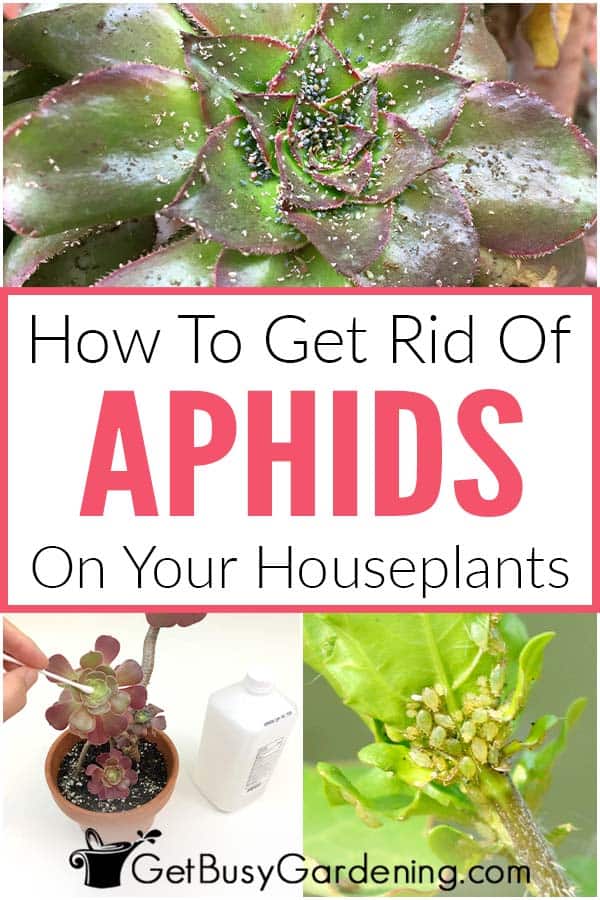

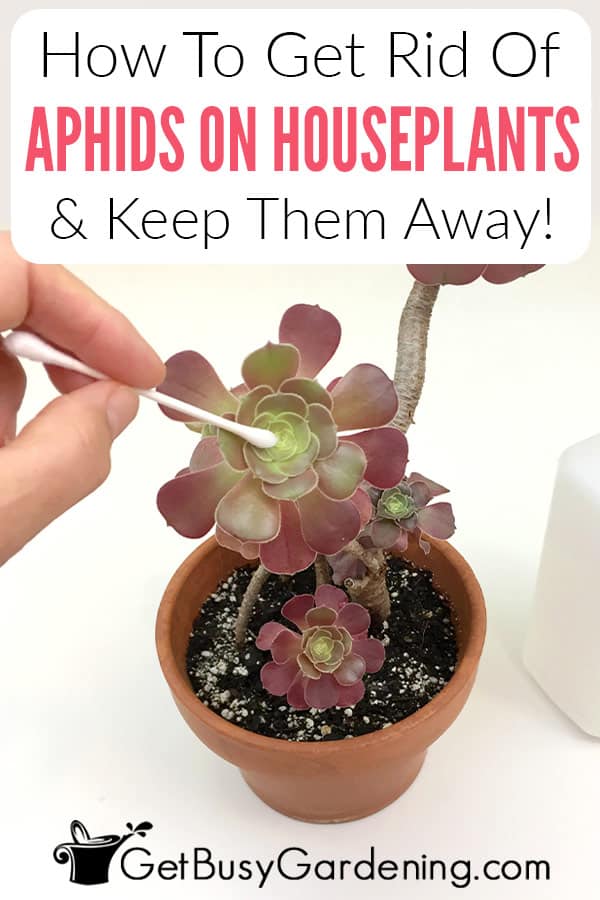
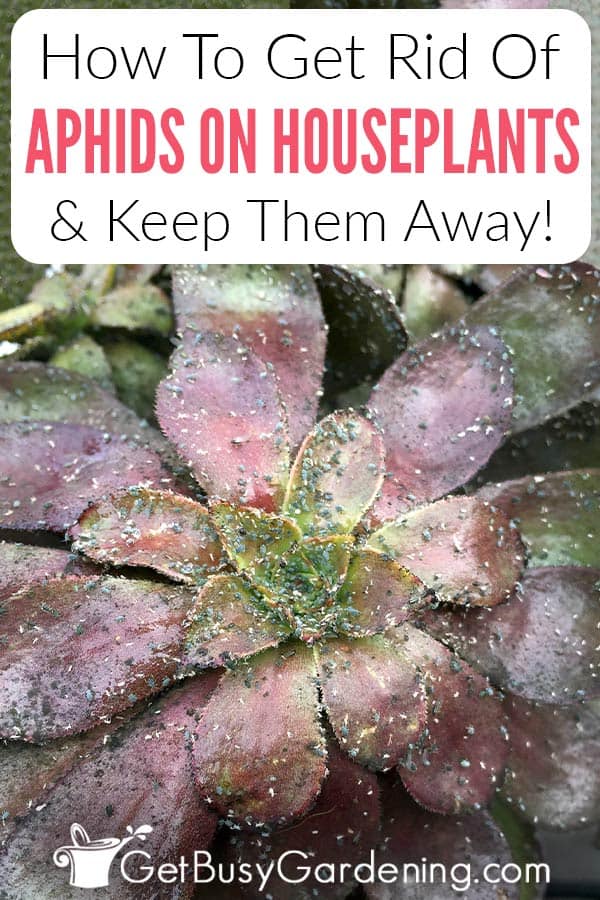
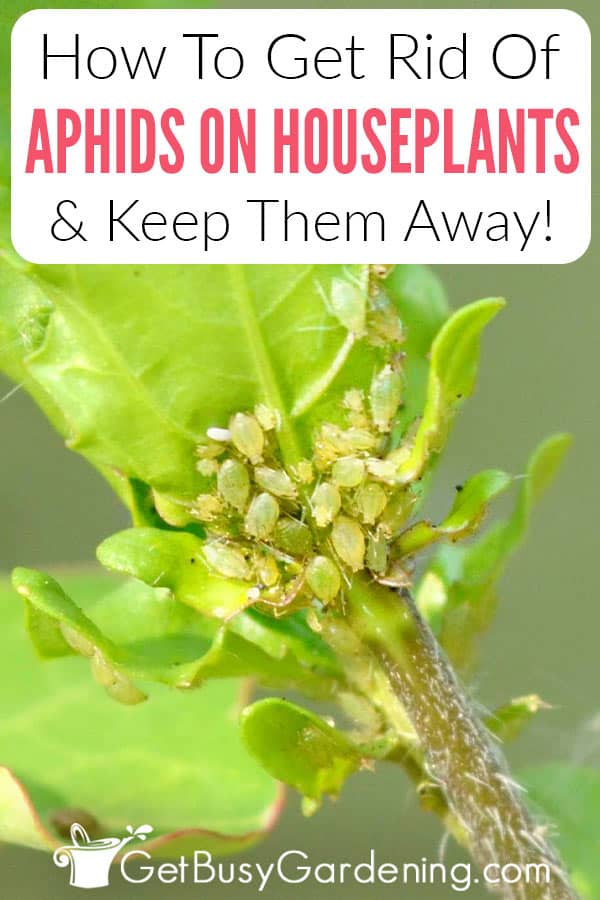
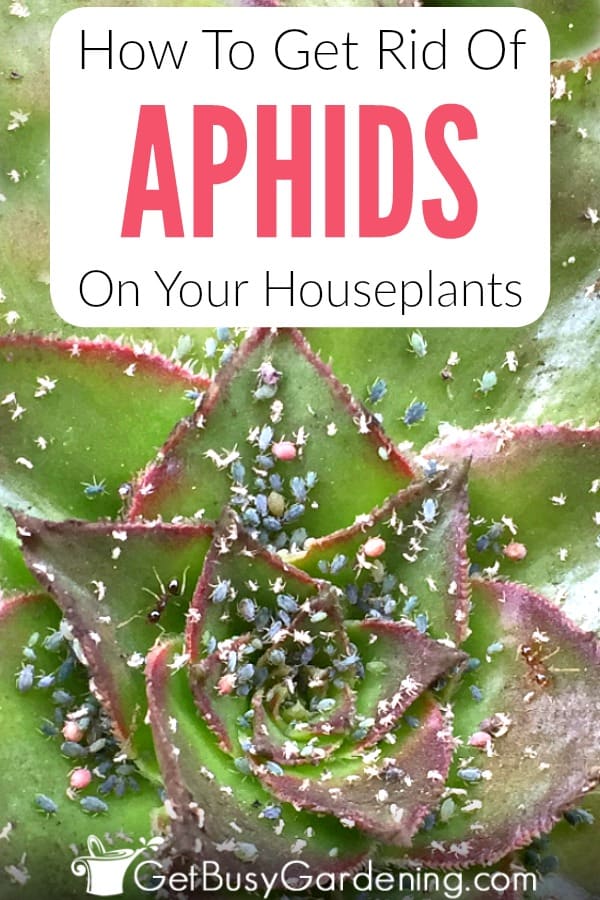



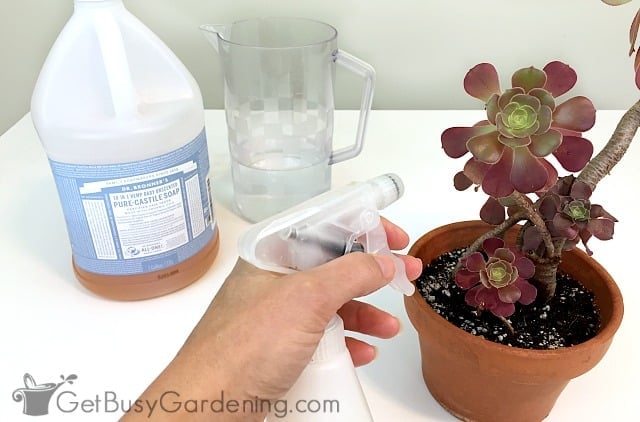
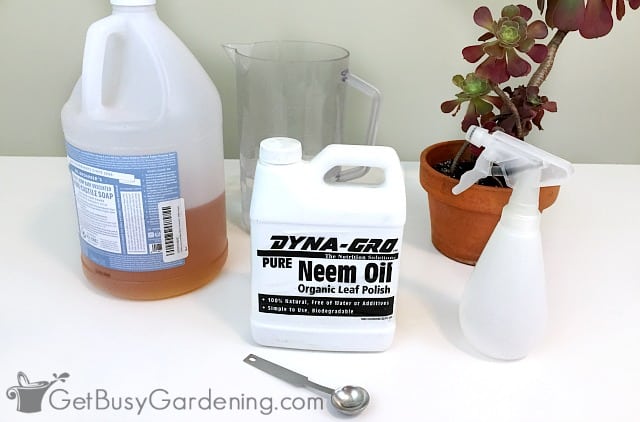
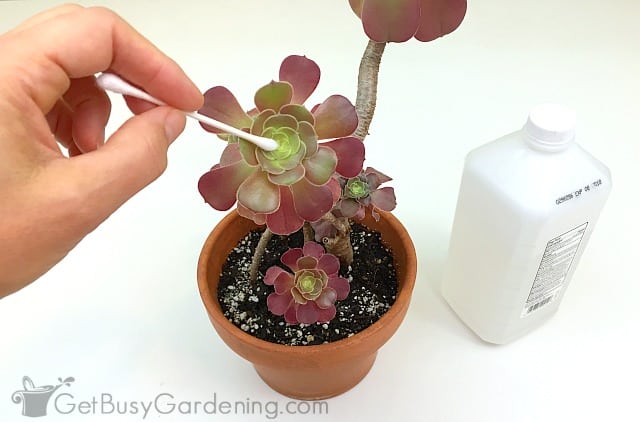
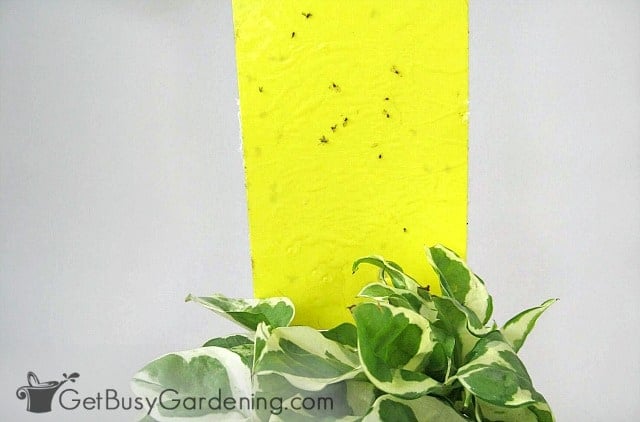
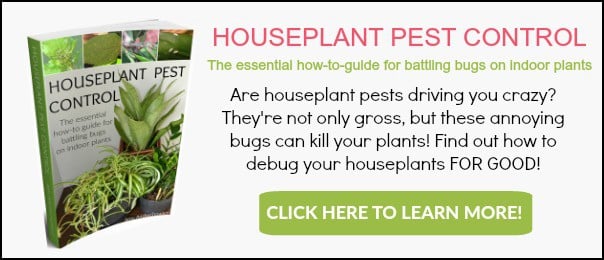

Golliwog says
The most effective way and safest way is to remove aphids and clusters of woolly aphids from plants and trees or fruit trees is to use a dry clean 50mm paint brush and simply brush them off the plant at first there will be large colonies of aphids but after a few inspections and brushing each day there will be none they simply die from dehydration throughout the summer months. Brush them off the plant and onto the ground once they are not on the plant they do no harm and the plant or tree stays healthy!
Amy Andrychowicz says
Great, thanks for sharing your method for getting rid of aphids on your plants.
Mona says
I don’t know what this is on my ficus plant, which seems to attack the base of the leaf stem on the underside. I try to post a picture of it in this comment, but I won’t allow me to do that. It is white and waxy looking and causes the leaf to yellow and fall off, it doesn’t look like a mealy bug or an aphid
Amy Andrychowicz says
Here’s a list of the most common houseplant pests and how to identify them.
Ilie says
Hi! This is a wonderful site! I have had a anthurium plant for 7 years that has stayed in bloom the entire time. It got aphids from a sister plant about the same age but never more than 4 blooms in 5.5 years.
I wonder how often do I wash with soap. Weekly, every few days?
Time to transplant them both, which I did about a year ago. Going to get new soil this weekend. Would it be good to use B vitamin at the time of transplanting it?
Amy Andrychowicz says
Oh no, sorry to hear you’ve been fighting aphids on your plant, that’s no fun. Check on your plants every couple of days for signs of new bugs. Once you have them under control, there’s no need to keep washing the leaves on a regular basis unless you continue to see aphids. If you don’t see any for a month, then just check every time you water. Vitamin B doesn’t nothing for plants, so there’s no need to use that.
Briana Kosior says
I have aphids and white flies on almost all my indoor plants. I have tried about every thing included neem oil, wiping off all leafs with soap and water, Damacious Earth, brushing them off with a paint brush, sticky traps. I even tried using chemicals such as seven with no luck. I’m at my wits end does anyone know what else I can try. I treat my plants once a week so I don’t damage them. Do I need to treat my plants more than that?
Amy Andrychowicz says
Neem oil is the way to go for recurring and widespread infestations like this. It takes time for the treatments to work though, so you have to be persistent and patient. Washing the leaves weekly should defiantly help, so keep doing that, and add neem oil treatments to your regiment too. Flying insects tend to take a bit longer, since they scatter when you spray them, and can easily fly from plant to plant. So make sure you’re treating all of your plants, even if they don’t show signs of bugs. Also, get some yellow sticky traps to capture the adults, which will help slow them down and control them faster. Here are a few other articles that should help you out too…
– How To Use Neem Oil Insecticide On Houseplants
– How To Get Rid Of Whiteflies On Indoor Plants, For Good!
Stan Shawn says
I’ve tried all the recommended methods of getting rid of aphids, and none of them worked. I discovered the best way is to mask off the soil around the base of the plant with paper and use a soft bristle paint brush and starting at the top, holding each part of the plant brush off all the aphids on to the table, and vacuum them up. Make sure to brush both sides of each leaf carefully. I eliminated 99% of the critters and just followed up the next day with the few that escaped.
Amy Andrychowicz says
Nice, thanks for sharing your method for getting rid of aphids on your plants! That’s sounds pretty effective. 🙂 The other methods do take persistence, and you have to continue treating the plant in order for them completely eradicate the bugs. Though your method sounds like it gets rid of the adults, it likely won’t kill the eggs and nymphs too. So keep an eye on your plant to make sure the aphids don’t start coming back. That is the main keys to success for any method.
Elise M Aromando says
My question is if we get rid of all of our indoor plants how long do we have to wait before introducing new plants. How long can the aphids and eggs live without a plant to feed on?
Amy Andrychowicz says
I have never tried this myself, but I believe that aphids can’t live more than a month without food. Good luck, hope you can get rid of them.
MK says
I just discovered some aphids on some grocery store bought mint plants that I have been propagating in a cup of water for the last two weeks! My cuttings are still quite small so was quite a surprise to find aphids on them! Your post is from quite some time ago, but I just tried giving each cutting a good rinse with strong water, and spraying them with soapy water. Fingers crossed this does the trick! And hopefully it hasn’t transferred to my other plants in pots around them!
Amy Andrychowicz says
Oh no! Bummer that your grocery store bought mint had aphids on it. It’s not uncommon for produce from the store to have bugs like this. You did the right thing by spraying them and washing the leaves with soapy water. Just keep in mind that it usually takes more than one treatment to get rid of aphids. So make sure to check the plant daily, and spray/wash it again if you see more. Good luck, and I hope they didn’t have time to spread to your other plants.
Christine Kostrubala says
I am taking care of this huge Monestera (sp) plant that just showed signs of aphids which is a major pain. I’m in the middle of many projects…I cannot give it a shower nor can I spray it. Is it alright that I to use towel with mixture of alcohol and water to wipe each leaves of aphids?
Amy Andrychowicz says
Oh no, so sorry to hear you found aphids on your Monestera! That’s no fun. Yes, using a damp cloth with water and rubbing alcohol will help to get rid of the aphids. But you’ll have to be consistent with it, because you won’t get rid of them all the first time. Keep wiping it ever few days until all signs of the aphids are gone. You could also try wetting the cloth with neem oil, and use that to wipe the leaves, rather than spraying it on the plant. Good luck!
Niki says
I have been growing hot pepper plants and I’ve tried just about everything to get rid of the aphids with no luck…they just keep coming back and I’m getting frustrated!
Amy Andrychowicz says
Have you tried neem oil yet? If so, maybe it wasn’t concentrated enough. It worked like a charm to get rid of the aphids on my pepper plants after only a few applications (but it might take more for yours).
Stan Shawn says
Same here. Brush them off with a soft paint brush and vacuum them up. It works better than any other method.
Gregg Ross says
How can I treat an aphid infestation on my milkweed plant without harming the monarch caterpillars
Amy Andrychowicz says
You can use a soapy water spray (I mix my own using 1 tsp of organic liquid soap and 1 liter of water) or an organic insecticidal soap to kill the aphids, and then give the plant a good rinse with the hose to wash them off. The soap doesn’t have any residual effect, so it won’t harm the monarchs. Look for ants too, they are notorious for bringing aphids to milkweed (last summer I took a video of the ants busy at work on some aphid infested milkweed near my house, it’s actually kinda cool to watch)
Donella says
We don’t have houseplants because of the pets, but my sister-in-law had the WORST problem with aphids in the house a couple of years ago. I think she threw her houseplants away out of frustration… LOL… but it’s great to know there’s a simple fix to get rid of the aphids!
Amy Andrychowicz says
I know exactly how she feels! Trying to get rid of aphids on houseplants can be soooo frustrating!
p3chandan says
Gee..I got my pests mixed up, I thought the white things on the stems and shoots of my tomato plants are aphids. I noticed I have ants on my cucumber plants but I thought they are good because they pollinate the flowers..but I haven’t seen aphids yet..so hope will never ever see them! Thanks for the info.
Amy Andrychowicz says
Uh oh, glad I could help identify your pest! The white ones could be whiteflies or mealybugs. Just because you have ants doesn’t mean they are bringing pests to a plant. Ants are good for pollination too, just like you mention. It’s good to keep your eyes open for pests whenever you see a lot of ants. Ladybugs love to eat aphids in the garden, so those are great to have around!